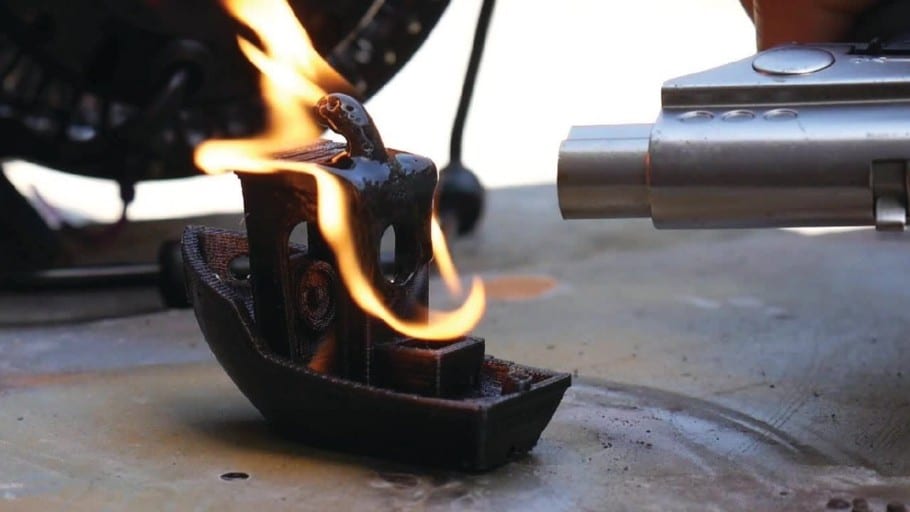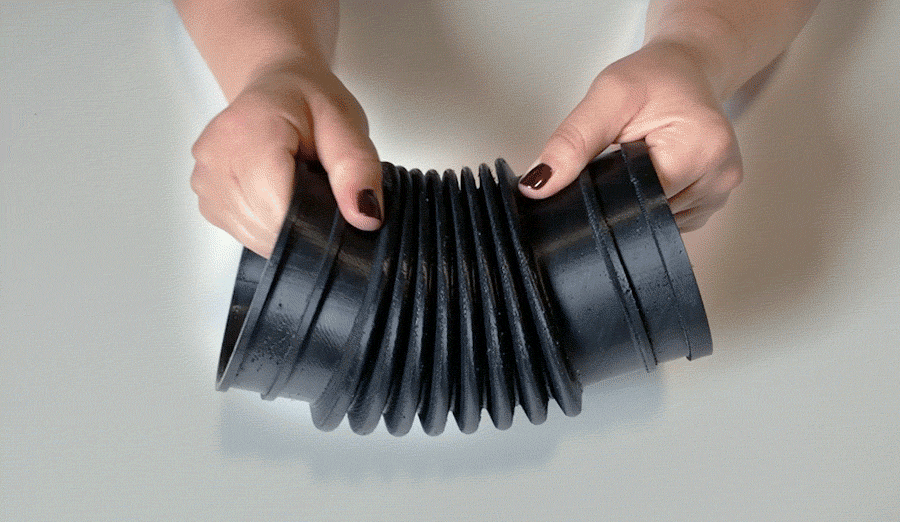Due to the fact that 3d printing is being used extensively in a wide array of industries, and serving numerous purposes, there is an ever-increasing catalog of available thermoplastics. Each one has its own advantages and disadvantages, and choosing the right one for each object is almost an art.
One dimension that should not be underestimated when choosing a filament type is the need (or not) for flame-retardant characteristics. Depending on the type of product and the area in which it will be placed, it may be very important to choose only filaments that will not burst into fire.
In short, which filaments are flammable?
Among the most popular filaments used in 3d printing, PLA is by far the most flammable. Additionally, parts made out of ABS will also catch on fire if exposed to high temperatures for prolonged periods of time. The most flame-retardant filaments readily available for 3d printing are TPU and PETG.
Is PLA Flammable?

Polylactic Acid, better known as PLA, is the most commonly used 3D printing filament. PLA is a plastic substitute manufactured from fermented plant starch.
Although it is an excellent thermoplastic for hobbyists, PLA’s high flammability and tendency to burn at low temperatures have severely limited its applicability for a wide array of industrial uses.
Is it safe to burn PLA
When burned, PLA may release fumes known as VOC (Volatile Organic Carbon). Although not all VOCs are toxic, their inhalation should be avoided at all costs in order to prevent health-related issues. It is widely known in the scientific community that VOCs can lead to pulmonary diseases like asthma and bronchitis.
Proper safety measures need to be taken before burning PLA.
Is ABS Flammable?
When exposed to high temperatures for prolonged periods of time, ABS is certainly flammable. The temperature achieved by a common wood fire is high enough to set ABS on fire. As is the case with most thermoplastics, it first starts to melt (at around 210°C), then to boil. The fumes caused by the boiling are the ones that are prone to burst into flames.
Is it safeto burn ABS?
Considering that ABS has no halogens, it does not normally produce any persistent organic pollutants when it is burned or pyrolyzed* and the most harmful products formed are carbon monoxide and hydrogen cyanide.
Having said that, carbon monoxide and hydrogen cyanide are a byproduct of ABS combustion. In addition to being harmful gases, they can cause suffocation. making it very unsafe to burn ABS.
*Priolization is the decomposition of materials at elevated temperatures in an inert atmoshpere.
Are there any flame-resistant ABS Filaments?
There are currently numerous ABS-based filaments whose composition includes different kinds of flame retardants.
The UL-94 code is none other than the flammability standard for polymers in the USA. Released by Underwriters Laboratories, it is also known as the “Standard for Safety of Flammability of Plastic Materials for Parts in Devices and Appliances testing”. The standard divides plastics into six categories based on how they burn in various orientations and component thicknesses.
Thermoplastics are then organized from less to most flame-retardant, following the following categories: HB, V-2, V-1, V-0, 5VB, 5VA.
In a nutshell, the least frame retardant category (HB), allows a burning rate of 76mm/min for a 3mm thick horizontal object, whereas the most flame-retardant category (5VA) have to stop burning in less than 60 seconds without producing drips and without producing holes in the object.
Keeping this range of categories in consideration, what follows is a list of flame retardant ABS filament
Flame-retardant ABS filaments
Because of the massification of 3d printing in the last couple of years, there is a large array of filaments to choose from. This obviously includes ABS filament spools that are specifically created to have flame-retarding properties. Although they are from 3 to 5 times more expensive than a regular 1kg spool of ABS, it is good to know that they are available in case you need them for a specific print.
Firewire flame retardant ABS
Firewire ABS-FR is a high-end UL-94 V-0 ABS that may be used to print functioning prototypes and production parts. The V-0 category requires components to stop burning in less than 10 seconds, allowing for drips that don’t produce flames.
As is the case with most ABS filaments, it has a somewhat high extrusion temperature of 220-240°C and does require a heated bed capable of reaching temperatures of 100-110°C.
This ABS also has a significantly stronger and unpleasant odor during printing. It’s best to use it in a well-ventilated environment or with HEPA and carbon filter systems.
Flame Retardant ABS by Atomic Filament
This filament does not have UL-940 certification (as far as I’m aware), although it is supposed to have the performance of a V-0 flame retardant. It prints very easily as compared to other filaments, at a high temperature of 235-255 C.
At the risk of sounding repetitive, this FR (flame-retardant) thermoplastic emits a strong chemical odor, and it should always be used with adequate ventilation.
Is PETG Flammable?
PETG, which is also known as Polyethylene Terephthalate Glycol, is another thermoplastic that is currently being used extensively in 3D printing. It is a durable material with high temperature resistance.
It is more flame-retarding than both ABS and PLA. The main advantage of PETG is that, although it will obviously melt, it won’t catch on fire.
Is it safe to burn PETG?
PETG is safer than bot PLA and ABS, but it is required nonetheless to take some safety measures in consideration when printing PETG for prolongued period of time (as is the case with all filaments).
Printing in a well-ventilated area in order to minimize our exposure to harmful emissions is a must. PETG emits high rates of caprolactam and overexposure of it can cause eye and respiratory tract irritation. In short, it is never safe to burn thermoplastics, including PETG, without proper safety precautions.
Is TPU Flammable?

TPU, or Thermoplastic Polyurethane, is a rubber-like material that is also pretty popular in the 3D printing sphere.
It is the least flammable of all common thermoplastics used and readily available in the market. Although it won’t catch on fire at all, it will of course melt and drip (otherwise it would not be possible to use it in 3d printing).
Is it safe to burn TPU?
TPU is not harmful in general and is suitable for a wide range of applications. Due to its incredible flexibility, it is widely used in tubing, medical devices, sporting products, cables, shoes, and wires, among other uses.
When burning TPU, hazardous gases including cyanide compounds and other hazardous chemicals are released. As is the case with all other thermoplastics, it is unsafe to stay in a room with a working 3d printer that is using TPU.
Conclusion
As previously discussed, we should avoid using PLA if flammability is a major concern. It is also worth noticing that, although ABS is also flammable under certain conditions, it is possible to buy variants of ABS that are specifically flame-retardant. They are of course much pricier.
Unless restricted because of another factor, the best option for flame-retarding thermoplastics is TPU and PETG. Keep in mind that TPU is a flexible filament, making it a rather strange substitute for PLA or ABS if rigidity is required. Having said that, PETG is the best option, unless UV resistance is also required.
Check out our recommended products section

We created a recommended products section that will allow you to remove the guesswork and reduce the time spent researching what printer, filament, or upgrades to get, since we know that this can be a very daunting task and which generally leads to a lot of confusion.
We have selected just a handful of 3D printers that we consider to be good for beginners as well as intermediates, and even experts, making the decision easier, and the filaments, as well as the upgrades listed, were all tested by us and carefully selected, so you know that whichever one you choose will work as intended.
Error processing API data.
